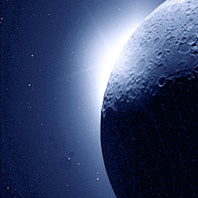Tag:
Astronomy
Who doesn’t enjoy seeing a shooting star in the night sky? It is said that a wish is granted, which is believed to come true if kept secret and not shared with anyone. And who doesn’t want our wishes to become a reality?
To put it in physical terms, a shooting star is a »meteor«, a luminous effect, which develops with the occurrence of a »meteoroid« (a more or less large lump of rock from space), which burns up in the earth’s atmosphere. Not to be mistaken, however, with a »meteorite«. A meteoroid is only called like that, if it hits the earth’s surface (and could actually cause immense damage). So, no need to be concerned: shooting stars are harmless and very beautiful to watch.
Read more
When looking at the Moon, how slowly it travels across the night sky, one could easily forget that we are moving with a staggering speed through space with our Earth and our Moon. Furthermore, there is the rotation of the orbs to each other, which remains hidden from our senses as well. Only the mind knows of these astronomic connections and only for a short period of time (measured by our existence).
Read more
Just recently, NASA found out, during an examination of video material, that a relatively large explosion took place on the Moon on 17th March 2013, caused by the impact of a meteoroid. This was an approximately 15 inches large and 88 pounds heavy chunk, which hit the Moon’s surface with 56,000 mph. The explosive power is equivalent to 5 tons of TNT. The flash of light which lit up during the impact in the »Mare Imbrium«, was so bright that it was visible with the naked eye from Earth.
Read more
Astrology, the teaching of the interpretation and meaning of star constellations for human life, shows once again the sun’s dominance in our society and the insignificant role the Moon plays. Everyone knows »his/her« sign of the zodiac, meaning the position of the Sun at the time of their birth. If you say, for example, »I am an Aquarius«, you refer to the fact that the Sun was positioned in the astrological sign Aquarius when you were born. Also, some people are still aware of the ascendant, being the sign, which was on the eastern horizon at the time of birth (lat. ascendere = to rise). But which sign the Moon is in their birth horoscope, only very few people know.
Read more
Today is the last day of 2012 and we asked ourselves when there has been or will be a full moon in the past or the future at the turn of the year. What a fascinating picture, if you are imagining also the full moon next to the firework welcoming the New Year. The spectacle of humans meets the eternal beauty of the universe …
Read more
More than 400 years ago, the German artist Adam Elsheimer (1578–1610) painted the picture »Flight into Egypt« (1609), where he depicted the well-known biblical scene of the escape of Joseph and Maria with the Christ Child. The special feature of this painting is, that it shows the full moon and night sky with such a richness of detail on a scale not seen before. Scientists – like for example Dr. Christian Sicka of the ›Deutsche Museum‹ Munich – have examined this work and come to the conclusion that this is possibly the first correct astronomical true to life depiction of the night sky in paintings. One can easily recognise the lunar maria on the Moon’s surface and also the Milky Way, moreover a clear graduation of brightness with the individual stars.
Read more
Looking at the Moon, you can recognise the spots on the surface with the naked eye, which are termed lunar maria and have always been inspiring people’s imagination. It is actually molten rock that rose to the surface during the origin of the Moon and then hardened. If looked at closer and using a telescope as an aid, you are able to make out mountains and valleys and a large amount of craters. In short: they are landscapes that give our Moon its face.
Read more
Who believes to see a staggering Moon at night, has probably had a drop too much, although a staggering movement of the Moon actually exists in astronomy. This is called »libration«, but happens very slowly and is therefore only visible by the naked eye in time-lapse photography.
The Moon orbits around the Earth in a so called synchronous rotation. This means that it always faces one hemisphere towards the Earth, while the reverse side of the Moon is not visible from Earth. Due to certain physical conditions (relating to orbits, angular velocity, centres of mass, among others), what happens is that the visible surface of the Moon varies slightly during the course of the moon cycle, and there is a gentle change of inclination of the Moon’s axis or it appears to turn a little.
Read more
The Moon circles the Earth. But indeed, it is no circle, but an ellipse, which portrays itself in space like a kind of spiral, because the Earth, together with the Moon, circles the Sun. And thus, the distance between the Earth and the Moon does not remain the same, but continuously changes. The distance varies between approx. 357,000 km/222,000 mi (called perigee) to approx. 406,000 km/252,000 mi (called apogee).
Read more
You always hear that certain things should be done or left undone at certain phases of the lunar cycle, also during a full moon. You can believe it or not. It surely cannot be proven and to be honest, we are quite skeptical with regards to the attribution of human activities and lunar events. However, we would not like to exclude it – after all neither the efficacy nor the inefficacy of such theses has been proven. As long as you don’t get caught in your own convictions, it is part of people’s liberty to create their lives freely.
Read more










